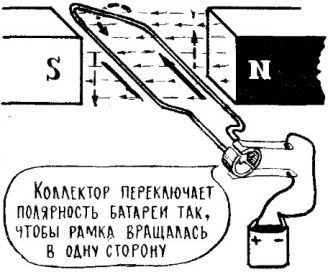Categories: Featured Articles » Novice electricians
Number of views: 110313
Comments on the article: 4
Inductors and magnetic fields
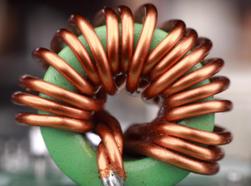 After the story on the use of capacitors It would be logical to talk about another representative of passive radioelements - inductors. But the story about them will have to start from afar, to remember the existence of a magnetic field, because it is the magnetic field that surrounds and penetrates the coils, it is in a magnetic field, most often alternating, that the coils work. In short, this is their habitat.
After the story on the use of capacitors It would be logical to talk about another representative of passive radioelements - inductors. But the story about them will have to start from afar, to remember the existence of a magnetic field, because it is the magnetic field that surrounds and penetrates the coils, it is in a magnetic field, most often alternating, that the coils work. In short, this is their habitat.
Magnetism as a property of matter
Magnetism is one of the most important properties of matter, as well as, for example, mass or electric field. The phenomena of magnetism, however, like electricity, have been known for a long time, only then science could not explain the essence of these phenomena. An incomprehensible phenomenon was called "magnetism" by the name of the city of Magnesia, which was once in Asia Minor. It was from ore mined nearby that permanent magnets were obtained.
But the permanent magnets in the framework of this article are not particularly interesting. As soon as it was promised to talk about inductors, then we will most likely talk about electromagnetism, because it is far from a secret that even around a wire with current there is a magnetic field.
In modern conditions, it is quite easy to investigate the phenomenon of magnetism at the initial, at least level. To do this, you need to assemble a simple electric circuit from a battery and a bulb for a flashlight. As an indicator of the magnetic field, its direction and intensity, you can use the usual compass.
DC magnetic field
As you know, the compass shows the direction to the North. If you place the wires of the simplest circuit mentioned above and turn on the light, the compass needle will deviate somewhat from its normal position.
By connecting another bulb in parallel, you can double the current in the circuit, which makes the rotation angle of the arrow slightly increase. This suggests that the magnetic field of the wire with current has become larger. It is on this principle that arrow measuring instruments work.
If the polarity of turning on the battery is reversed, then the compass needle will turn to the other end - the direction of the magnetic field in the wires also changed in direction. When the circuit is turned off, the compass needle will return to its rightful position. There is no current in the coil, and there is no magnetic field.
In all of these experiments, the compass plays the role of a test magnetic needle, just as a study of a constant electric field is performed by a test electric charge.
Based on such simple experiments, we can conclude that magnetism is born due to electric current: the stronger this current, the stronger the magnetic properties of the conductor. And then where does the magnetic field of the permanent magnets come from, since no one connected the battery with wires to them?
Fundamental scientific research has proved that permanent magnetism is based on electrical phenomena: each electron is in its own electric field and has elementary magnetic properties. Only in most substances, these properties are mutually neutralized, and for some reason, for some reason, they form one large magnet.
Of course, in fact, everything is not so primitive and simple, but, in general, even permanent magnets have their wonderful properties due to the movement of electric charges.
And what kind of magnetic lines are they?
Magnetic lines can be seen visually. In school experience, in physics lessons, metal filings are poured onto a sheet of cardboard, and a permanent magnet is placed below. Lightly tapping on a sheet of cardboard can achieve the picture shown in Figure 1.
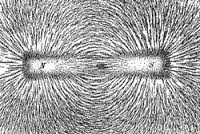
Picture 1.
It is easy to see that magnetic lines of force leave the north pole and enter the south, without breaking. Of course, we can say that it is, on the contrary, from the south to the north, but it is so customary, therefore, from the north to the south. In the same way as they once adopted the direction of the current from plus to minus.
If, instead of a permanent magnet, a current wire is passed through a cardboard, then metal filings will show it, the conductor, the magnetic field. This magnetic field has the form of concentric circular lines.
To study the magnetic field, you can do without sawdust. It is enough to move the test magnetic arrow around the current conductor to see that the magnetic lines of force are indeed closed concentric circles. If we move the test arrow to the side where the magnetic field deflects it, we will certainly return to the same point from where the movement began. Similarly, as walking around the Earth: if you go nowhere without turning, then sooner or later you will come to the same place.
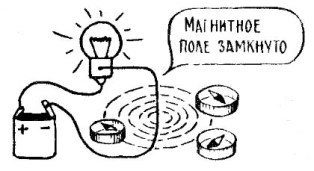
Figure 2
Gimlet rule
The direction of the magnetic field of a conductor with current is determined by the rule of the gimlet, a tool for drilling holes in a tree. Everything is very simple here: the gimlet must be rotated so that its translational motion coincides with the direction of the current in the wire, then the direction of rotation of the handle will show where the magnetic field is directed.
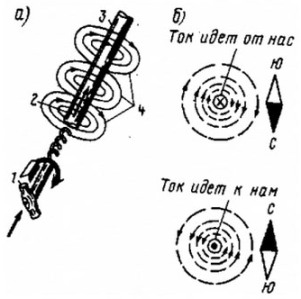
Figure 3
“The current is coming from us” - the cross in the middle of the circle is the plumage of an arrow flying beyond the plane of the picture, and where “The current is coming towards us”, the tip of the arrow flying from behind the plane of the sheet is shown. At least, such an explanation of these designations was given in physics lessons at school.
The interaction of the magnetic fields of two conductors with current
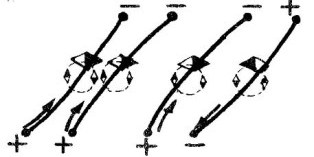
Figure 4
If we apply the gimlet rule to each conductor, then having determined the direction of the magnetic field in each conductor, we can say with confidence that conductors with the same current direction are attracted, and their magnetic fields add up. Conductors with currents of different directions are mutually repulsive, their magnetic field is compensated.
Inductor
If the conductor with current is made in the form of a ring (coil), then it has its own magnetic poles, north and south. But the magnetic field of one turn is usually small. You can achieve much better results by wrapping the wire in the form of a coil. Such a part is called an inductor or simply an inductance. In this case, the magnetic fields of the individual turns add up, mutually reinforcing each other.

Figure 5
Figure 5 shows how to obtain the sum of the magnetic fields of the coil. It seems to be possible to power each turn from its source, as shown in Fig. 5.2, but it is easier to connect the turns in series (just wrap them with one wire).
It is quite obvious that the more turns the coil has, the stronger its magnetic field. Also, the magnetic field also depends on the current through the coil. Therefore, it is legitimate to evaluate the ability of a coil to create a magnetic field simply by multiplying the current through the coil (A) by the number of turns (W). This value is called ampere - turns.
Core coil
The magnetic field generated by the coil can be significantly increased if a core of ferromagnetic material is introduced into the coil. Figure 6 shows a table with the relative magnetic permeability of various substances.
For example, transformer steel will make the magnetic field approximately 7..7.5 thousand times stronger than in the absence of a core. In other words, inside the core, the magnetic field will rotate the magnetic needle 7,000 times stronger (this can only be imagined mentally).
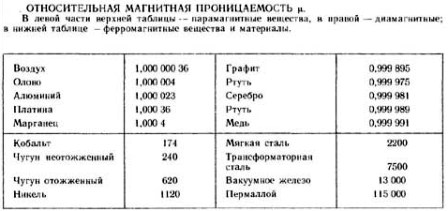
Figure 6
Paramagnetic and diamagnetic substances are located at the top of the table. Relative magnetic permeability µ is indicated relative to vacuum. Consequently, paramagnetic substances slightly enhance the magnetic field, while diamagnetic substances slightly weaken.In general, these substances do not have a special effect on the magnetic field. Although, at high frequencies, brass or aluminum cores are sometimes used to adjust the contours.
At the bottom of the table are ferromagnetic substances that significantly enhance the magnetic field of the coil with current. So, for example, a core made of transformer steel will make the magnetic field stronger exactly 7,500 times.
How and how to measure the magnetic field
When units were needed to measure electrical quantities, the electron charge was taken as a reference. A very real and even tangible unit was formed from the charge of an electron - a pendant, and on its basis everything turned out to be simple: ampere, volt, ohm, joule, watt, farad.
And what can be taken as a starting point for measuring magnetic fields? Somehow attach to the magnetic field of the electron is very problematic. Therefore, a conductor is adopted as a unit of measure in magnetism, through which a direct current of 1 A flows.
Magnetic field characteristics
The main such characteristic is tension (H). It shows with what force the magnetic field acts on the test conductor mentioned above, if it happens in a vacuum. The vacuum is intended to exclude the influence of the environment, therefore this characteristic - tension is considered absolutely clean. Ampere per meter (a / m) is taken as the unit of tension. Such tension appears at a distance of 16 cm from the conductor, along which 1A current flows.
The field strength speaks only of the theoretical ability of the magnetic field. The real ability to act reflects a different value of magnetic induction (B). It is she who shows the real force with which the magnetic field acts on a conductor with a current of 1A.

Figure 7
If a current of 1A flows in a conductor 1 m long, and it is pushed out (attracted) with a force of 1 N (102 G), then they say that the magnitude of the magnetic induction at this point is exactly 1 Tesla.
Magnetic induction is a vector quantity, in addition to the numerical value, it also has a direction that always coincides with the direction of the test magnetic needle in the magnetic field under study.

Figure 8
The unit of magnetic induction is Tesla (TL), although in practice they often use a smaller unit of Gauss: 1TL = 10,000G. Is it a lot or a little? The magnetic field near a powerful magnet can reach several T, near the magnetic needle of the compass no more than 100 G, the Earth’s magnetic field near the surface is about 0.01 G or even lower.
Magnetic flux
The magnetic induction vector B characterizes the magnetic field at only one point in space. In order to evaluate the effect of a magnetic field in a certain space, another concept such as magnetic flux (Φ) is introduced.
In fact, it represents the number of lines of magnetic induction passing through a given space, through some area: Φ = B * S * cosα. This picture can be represented in the form of raindrops: one line is one drop (B), and together it is the magnetic flux Φ. This is how power magnetic lines of individual coil turns are connected into a common stream.

Figure 9
In the SI system, Weber (Wb) is taken as the unit of magnetic flux, such a flux occurs when an induction of 1 T acts on an area of 1 sq.m.
Magnetic circuit
The magnetic flux in various devices (motors, transformers, etc.), as a rule, passes in a certain way, called a magnetic circuit or simply a magnetic circuit. If the magnetic circuit is closed (the core of the ring transformer), then its resistance is small, the magnetic flux passes unhindered, is concentrated inside the core. The figure below shows examples of coils with closed and open magnetic circuits.
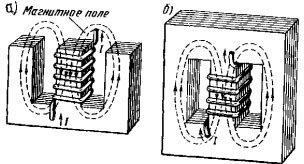
Figure 10
Magnetic circuit resistance
But the core can be cut and a piece can be pulled out of it, to make a magnetic gap. This will increase the overall magnetic resistance of the circuit, therefore, reduce the magnetic flux, and generally reduce the induction in the entire core.It’s the same as soldering a lot of resistance in an electric circuit.
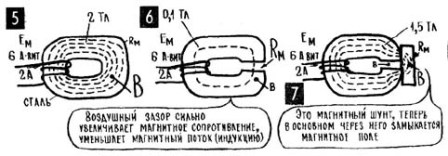
Figure 11.
If the resulting gap is closed with a piece of steel, it turns out that an additional section with a lower magnetic resistance was connected parallel to the gap, which will restore the disturbed magnetic flux. This is very similar to a shunt in electrical circuits. By the way, there is also a law for the magnetic circuit, which is called Ohm's law for the magnetic circuit.

Figure 12.
The main part of the magnetic flux will go through the magnetic shunt. It is this phenomenon that is used in magnetic recording of audio or video signals: the ferromagnetic layer of the tape covers the gap in the core of the magnetic heads, and the entire magnetic flux is closed through the tape.
The direction of the magnetic flux generated by the coil can be determined using the rule of the right hand: if four outstretched fingers indicate the direction of current in the coil, the thumb will show the direction of the magnetic lines, as shown in Figure 13.

Figure 13.
It is believed that magnetic lines leave the north pole and go into the south. Therefore, the thumb in this case indicates the location of the south pole. Check whether this is so, you can again using the compass needle.
How the electric motor works
It is known that electricity can create light and heat, participate in electrochemical processes. After getting acquainted with the basics of magnetism, you can talk about how electric motors work.
Electric motors can be of a very different design, power and principle of operation: for example, direct and alternating current, step or collector. But with all the variety of designs, the principle of operation is based on the interaction of the magnetic fields of the rotor and stator.
To obtain these magnetic fields, current is passed through the windings. The greater the current, and the higher the magnetic induction of an external magnetic field, the more powerful the engine. Magnetic cores are used to strengthen this field, so there are so many steel parts in electric motors. Some DC motor models use permanent magnets.
Figure 14.
Here, you can say, everything is clear and simple: they passed a current through the wire, received a magnetic field. Interaction with another magnetic field makes this conductor move, and even perform mechanical work.
The direction of rotation can be determined by the rule of the left hand. If four outstretched fingers indicate the direction of the current in the conductor, and the magnetic lines enter the palm of your hand, the bent thumb will indicate the direction of ejection of the conductor in a magnetic field.
Continuation: Inductors and magnetic fields. Part 2. Electromagnetic induction and inductance
See also at bgv.electricianexp.com
:

